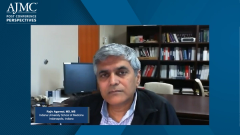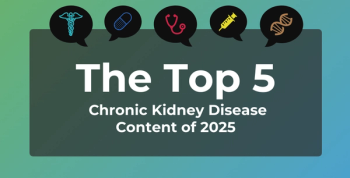
Results From FIGARO-DKD and FIDELITY: Finerenone + SGLT2 Inhibitors
Considerations for the benefit shown in combining finerenone with SGLT2 inhibitors in patients with type 2 diabetes and CKD.
Episodes in this series

Transcript:
Rajiv Agarwal, MD, MS: The SGLT2 inhibitors are an absolutely amazing class of drugs, and 7% of the patients in the FIDELITY analysis were on SGLT2 inhibitors. When we look at the outcomes of patients who are on both drugs, and we look at the outcomes of patients who are not on SGLT2 inhibitors, the benefits are similar between the 2 drugs. You have an interaction P value of .41. In both cases, the upper bound of the hazard ratio of cardiovascular benefit is below 1, which means that in both situations you have cardiovascular protection. Remember, the SGLT2 inhibitor group was not a randomized population. When we ask, does the combination do more good? You can’t really draw a cause-and-effect relationship simply because they had a bigger benefit with SGLT2 inhibitors because you’re not randomizing the SGLT2 inhibitor group.
It might also mean that these are patients who are treated at sites that know what they’re doing, and they might see a better benefit from finerenone. These patients might have persisted with finerenone for a longer period. They might have characteristics that differ from people who are not on SGLT2 inhibitors. Believing a cause-and-effect relationship between combination vs not in combination is dangerous. However, if you look at a recent basic science study that looked at empagliflozin 10 mg vs finerenone 10 mg vs a combination of the 2 in rodents who had kidney disease, we found that when you use a combination, you achieve more than either drug alone in the rodent kidney.
We have some basic science data to support the use of the combination. Whether that should be the strategy in the future, it’s quite possible and likely that the 2 will be beneficial together, mostly because when we combine an SGLT2 inhibitor with finerenone, there’s less likelihood of hyperkalemia. In fact, we’ve done this analysis. I presented these data at the World Congress of Nephrology in April 2021 that showed in people who are SGLT2 inhibitor users at baseline, in the FIDELIO-DKD trial, the risk of hyperkalemia was lower. If it can lower the risk of hyperkalemia and cause a greater persistence of the drug to occur, then it’s possible that the 2 are better together than just 1 alone.
This is the central message, that we shouldn’t be comparing and competing with the drugs because the prognosis of a patient who goes on dialysis who has type 2 diabetes is worse than that of a patient with colon cancer. That’s the population that we should be targeting with a maximized therapy to prevent them going from dialysis. Finerenone clearly shows that you can reduce the risk by 20%.
Transcript edited for clarity.
Newsletter
Stay ahead of policy, cost, and value—subscribe to AJMC for expert insights at the intersection of clinical care and health economics.






























































